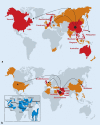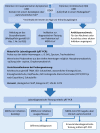[Coronaviruses as the cause of respiratory infections]
- PMID: 31455974
- PMCID: PMC7079972
- DOI: 10.1007/s00108-019-00671-5
[Coronaviruses as the cause of respiratory infections]
Abstract
Background: There are six human pathogenic coronaviruses (CoV), which mainly cause infections of the respiratory system. In everyday clinical practice, it is helpful to know the relevance and characteristics of these pathogens.
Objective: To present the epidemiology, clinical picture and differences of human pathogenic CoV and to provide information on the diagnostics and treatment of patients suspected of having CoV infections.
Material and methods: Selective literature search, presentation of results and discussion of fundamental works and expert recommendations, including publications by the World Health Organization (WHO), the European Centre for Disease Prevention and Control (ECDC) and the Robert Koch Institute.
Results: The four endemic human CoVs (HCoV-NL63, HCoV-229E, HCoV-OC43 and HCoV-HKU1) mainly cause mild respiratory tract infections. In addition to these four endemic HCoV, the two epidemic CoV, severe acute respiratory syndrome (SARS)-CoV and Middle East respiratory syndrome (MERS)-CoV can cause severe pneumonia. The SARS-CoV has not been detected in humans in the last 15 years and MERS-CoV has been circulating mainly on the Arabian Peninsula since 2012; however, neither a specific treatment nor approved vaccines exist for any of the six human pathogenic CoVs.
Conclusion: All six human CoVs can be diagnosed using RT-PCR on respiratory specimens but this is rarely necessary for the four endemic strains. In current clinical practice SARS-CoV has no importance as it has not been detected in humans for 15 years; however, a possible MERS-CoV infection should be taken into account in patients with typical symptoms and travel history to endemic regions. In this case, rapid diagnostic and general hygiene practices are important to prevent further transmission.
Hintergrund: Es gibt sechs humanpathogene Coronaviren (CoV), die vornehmlich respiratorische Infektionen auslösen. Im klinischen Alltag ist es hilfreich, Relevanz und Besonderheiten dieser Erreger zu kennen.
Fragestellung: Praxisnahe Darstellung der Epidemiologie, Klinik und Unterschiede humanpathogener CoV. Hinweise zu Diagnostik und Umgang mit Patienten bei Verdacht auf eine CoV-Infektion.
Material und Methoden: Selektive Literaturrecherche, Darstellung und Diskussion von Grundlagenarbeiten und Expertenempfehlungen einschließlich der Veröffentlichungen der Weltgesundheitsorganisation (WHO), des Europäischen Zentrums für die Prävention und die Kontrolle von Krankheiten (ECDC) und des Robert Koch-Instituts.
Ergebnisse: Die weltweit endemischen CoV (HCoV-NL63, -229E, -OC43 und -HKU1) sind häufige Ursache von leichteren respiratorischen Infektionen. Zwei epidemische, zoonotische Coronaviren (SARS- und MERS-CoV, MERS „Middle East respiratory syndrome“, SARS „severe acute respiratory syndrome“ [schweres akutes Atemwegssyndrom]) können schwere Pneumonien hervorrufen. SARS-CoV ist seit 15 Jahren nicht mehr im Menschen nachgewiesen worden. MERS-CoV zirkuliert seit 2012 hauptsächlich auf der Arabischen Halbinsel. Eine spezifische Therapie oder zugelassene Impfung existiert noch für keines der sechs humanpathogenen Coronaviren.
Schlussfolgerung: Eine Erregerdiagnostik mittels Polymerase-Kettenreaktion aus respiratorischem Material ist für alle CoV möglich, für die vier endemischen allerdings selten notwendig. SARS-CoV hat aktuell keine Relevanz in der Klinik, da es seit 15 Jahren nicht mehr im Menschen nachgewiesen wurde. Der Verdacht auf eine MERS-Infektion sollte hingegen bei entsprechender Symptomatik und Reiseanamnese differenzialdiagnostisch in Betracht gezogen werden. Hier sind eine schnelle Diagnosesicherung und allgemeine Hygienemaßnahmen zur Verhinderung der Verbreitung entscheidend.
Keywords: Common cold; Middle East respiratory syndrome coronavirus (MERS-CoV); Pneumonia; Respiratory tract infections; Severe acute respiratory syndrome (SARS).
References
Publication types
MeSH terms
LinkOut - more resources
Full Text Sources
Other Literature Sources
Miscellaneous




